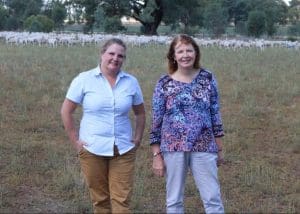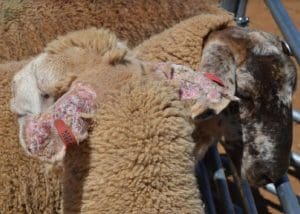
Associate Professor Jane Quinn and Professor Leslie Weston
NEW South Wales researchers have released guidelines for minimising photosensitisation in sheep grazing the popular annual legume biserrula.
Researchers from the Graham Centre for Agricultural Innovation said the hard-seeded annual has been embraced by farmers as a handy break in the cropping system, but livestock grazing the pasture can be affected by photosensitisation.
The best practice guide, ‘Understanding photosensitisation in sheep grazing biserrula pastures’ has been released after grazing trials led by Professor Leslie Weston and Associate Professor Jane Quinn from Charles Sturt University in Wagga Wagga.
Professor Quinn said Biserrula photosensitisation occured when animals ingest biserrula plants that produce photodynamic chemicals causing direct damage to skin in the presence of sunlight.
“In some cases severe damage to the skin can occur with resulting fleece loss.
“The initial signs of photosensitisation can arise quickly, within as little as three days of sheep grazing pastures,” she said.
“Producers should become familiar with the range and severity of symptoms so they can act quickly to minimise the number of animals affected and the severity of symptoms.
“Promptly removing animals from biserrula-dominant pasture as soon as mild signs appear and providing an alternative feed source reduces the intensity of injury and improves recovery time.”
Merinos and pigmented sheep less affected

A lamb showing photosensitisation and an unaffected pigmented lamb. Photo – J. Quinn and L. Weston.
Sheep breed and genotype, along with underlying health issues such as worms or liver fluke, have also been shown to affect the incidence and severity of photosensitisation.
Researchers found pigmented sheep generally do not exhibit visible signs of photosensitisation and Merino sheep appear to be less affected by photosensitisation than cross-bred sheep. This is most likely due to Merinos having better wool coverage around the ears and face, they said. Shearing time might also affect susceptibility and non-pigmented (white) shedding sheep are most susceptible to photosensitisation.
Professor Leslie Weston said the grazing trials also highlighted the impact of other species in the pasture.
“We found reduced severity of photosensitisation in sheep grazing pastures with 10 to 30 per cent annual ryegrass or mixed stands of biserrula containing significant percentages of other forages.
“However the incidence of photosensitisation was never mitigated completely,” Professor Weston said.
“Another important thing to note is that photosensitisation was not recorded in any animals in the trials when grazing fully dried biserrula pasture, regardless of the percentage of biserrula in the sward.
“This is a useful management strategy as dried forage biserrula has a high protein content and a maintenance energy level for mature dry sheep,” she said.
The research was funded by Meat and Livestock Australia, and the guide can be downloaded here.
The Graham Centre is a research alliance between CSU and the NSW Department of Primary Industries.
Source: Graham Centre for Agricultural Innovation.

HAVE YOUR SAY